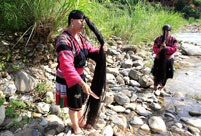


(Graphics: GT)
Seven months after ground was broken for Indonesia's first high-speed railway, which is being developed by a China-Indonesia joint venture, the project received a construction permit for its entire length, media reports said Sunday.
Experts said Sunday that construction should be completed within three years as planned, -despite concerns that work might be delayed.
Domestic news portal caixin.com reported on Sunday that the developer of the Jakarta--Bandung high-speed rail project, PT Kereta Cepat Indonesia China (KCIC), recently received a construction permit that covers the entire 142 kilometers line. The portal cited sources from China Railway Corp (CRC).
KCIC is a consortium consisting of CRC and four Indonesian state-owned companies.
The source told Caixin that work on the line has been progressing as planned, with absolutely no possibility of a halt, and the person noted that the Ministry of Transportation of Indonesia now lists the railway as a high-priority project.
But construction of the railway linking -Jakarta and Bandung, the largest and third-largest cities in Indonesia, has been hindered by licensing woes.
After the ground-breaking ceremony on -January 21, KCIC only had a permit to work on a section of 5 kilometers. By the end of June, the permit covered just 56.8 kilometers, or two-fifths of the entire length of the railway, -according to Caixin.
The Jakarta-Bandung high-speed railway, with a maximum designed speed of 350 kilometers per hour, will reduce travel time between the two cities to 40 minutes from more than three hours at present and is planned to be completed in three years, according to the CRC.
Although permits have been slower in coming than expected, KCIC can finish the project within three years, experts said.
"The consortium is capable of finishing the project within 18 months, and it took into consideration that some delays might occur during the construction phase," Wang Mengshu, -academician at the Chinese Academy of -Engineering, told the Global Times on Sunday.
Land acquisition, another factor affecting the progress of the project, should also go smoothly, Xu Liping, a research fellow from the National Institute of International Strategy at the Chinese Academy of Social Sciences, told the Global Times on Sunday.
"The majority of the land the railway will run through belongs to state-owned firms in Indonesia, with private land accounting for only a small part, so land acquisition should be relatively easy," Xu said, noting that the developer must pay close attention to coordination during construction work.
Differences between the national conditions of the two countries and their respective cultures should be observed, Xu said.
"The developer should also work seamlessly with local partners and abide by local laws. It should also formulate emergency action plans, including those covering security. These approaches can help safeguard construction of the railway to make progress according to its agenda," Xu said.
The construction of the railway is expected to create 40,000 jobs a year in Indonesia, according to media reports.
In March, KCIC was granted the right to operate the Jakarta-Bandung railway line for 50 years, starting from May 31, 2019.
The project is set to cost $5.13 billion.
 World's fastest bullet train to start operating next month
World's fastest bullet train to start operating next month Huangluo: China's 'long hair village'
Huangluo: China's 'long hair village' Spectacular bridge with one of the tallest piers in the world
Spectacular bridge with one of the tallest piers in the world Magnificent view of Hukou Waterfall
Magnificent view of Hukou Waterfall A glimpse of Stride 2016 Zhurihe B military drill
A glimpse of Stride 2016 Zhurihe B military drill US Navy chief tours Liaoning aircraft carrier
US Navy chief tours Liaoning aircraft carrier Chinese American woman wins Miss Michigan
Chinese American woman wins Miss Michigan Centenarian couple takes first wedding photos
Centenarian couple takes first wedding photos Traditional Tibetan costumes presented during fashion show
Traditional Tibetan costumes presented during fashion show Top 10 livable Chinese cities
Top 10 livable Chinese cities Top 20 hottest women in the world in 2014
Top 20 hottest women in the world in 2014 Top 10 hardest languages to learn
Top 10 hardest languages to learn China’s Top 10 Unique Bridges, Highways and Roads
China’s Top 10 Unique Bridges, Highways and Roads Pragmatism raises hope for Myitsone Dam
Pragmatism raises hope for Myitsone Dam Chinese Catholics split over cardinal’s article about China-Vatican negotiations
Chinese Catholics split over cardinal’s article about China-Vatican negotiations Helpful hacker forums close after arrest for revealing vulnerabilities
Helpful hacker forums close after arrest for revealing vulnerabilities 'Born in China' uses drama and cute animals to promote environmental message
'Born in China' uses drama and cute animals to promote environmental messageDay|Week